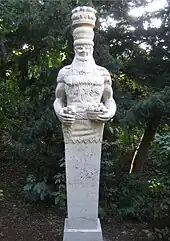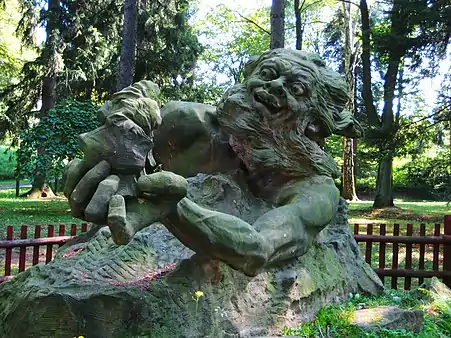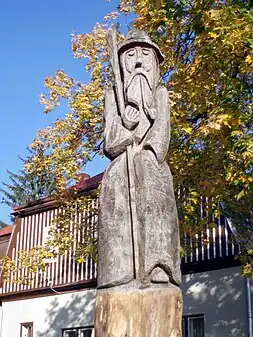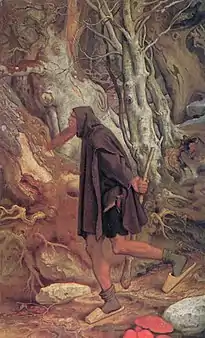Rübezahl
Rübezahl (Polish: Liczyrzepa, Duch Gór, Karkonosz, Rzepiór, or Rzepolicz; Czech: Krakonoš) is a folkloric mountain spirit (woodwose) of the Giant Mountains (Czech: Krkonoše, Polish: Karkonosze, hence his name in Czech and Polish), a mountain range along the border between the Czech Republic and Poland. He is the subject of many legends and fairy tales in German, Polish, and Czech folklore.

Name

The origin of the name is not clear. One interpretation is from the story How Rübezahl Got his Name by Johann Karl August Musäus, which recounts how Rübezahl abducted a princess who liked turnips (German: Rüben, singular Rübe). The princess gets very lonely there in the mountains. To keep her company, Rübezahl turns the turnips into her friends and acquaintances. As the turnips wilt after a little while, so do the persons that were created by Rübezahl's magic. The princess asks him to count (zählen) the turnips in the field. While he counted, she escaped.[1] Following this explanation, some early English writers translated his name as "Number Nip" (that is, "turnip numberer"), including the 1911 Encyclopædia Britannica.[2][3]
Another proposed etymology is Riebezagel, from a combination of the personal name Riebe and the Middle High German zagel, meaning "tail", from his pictorial representation as a tailed demon. According to the etymologist Friedrich Kluge, the name is a contraction of Middle High German Ruobezagel, ‘turnip-tail’.[4]
Rübezahl is a name of ridicule, the use of which provokes his anger. Respectful names are "Lord of the Mountain(s)" (Herr vom Berge, Herr der Berge), "Treasure Keeper" (Schatzhüter) or among herbalists "Lord John" (Herr Johannes, Latin vocative: Domine Johannes).[5][6] In one Silesian folktale, he is called "Prince of the Gnomes" (Fürst der Gnomen).[7]
The Polish name Liczyrzepa is a direct translation of the German name, introduced by Stanisław Bełza in 1898. It only became widespread in Poland after 1945 when Józef Sykulski started to translate tales of Rübezahl from German into Polish.[8] The Czech name, Krakonoš, is simply derived from the name of the mountains.
Legends
Denn Freund Rübezahl sollt ihr wissen, ist geartet wie ein Kraftgenie, launisch, ungestüm, sonderbar; bengelhaft, roh, unbescheiden; stolz, eitel, wankelmüthig, heute der wärmste Freund, morgen fremd und kalt; zu zeiten guthmüthig, edel, und empfindsam; aber mit sich selbst in stetem Widerspruch; albern und weise, oft weich und hart in zween Augenblicken, wie ein Ey, das in siedend Wasser fällt; schalkhaft und bieder, störrisch und beugsam; nach der Stimmung, wie ihn Humor und innrer Drang beym ersten Anblick jedes Ding ergreifen läßt.
— Translation: "...Rübezahl, you should know, has the nature of a powerful genius: capricious, impetuous, peculiar, rascally, crude, immodest, haughty, vain, fickle, today your warmest friend, tomorrow alien and cold; ...roguish and respectable, stubborn and flexible..."
—Musäus, Volksmährchen der Deutschen. Zweiter Theil containing Legenden von Rübezahl, 1783

In legends, Rübezahl appears as a capricious giant, gnome, or mountain spirit. With good people he is friendly, teaching them medicine and giving them presents. If someone derides him, however, he exacts a severe revenge. He sometimes plays the role of a trickster in folk tales.[7]
The stories originate from pagan times. Rübezahl is the fantastic lord of weather of the mountains and is similar to the Wild Hunt. Unexpectedly or playfully, he sends lightning and thunder, fog, rain and snow from the mountain above, even while the sun is shining. He may take the appearance of a monk in a gray frock (like Wotan); he holds a stringed instrument in his hand (the storm harp) and walks so heavily that the earth trembles around him.
In Czech fairytales, Rübezahl (Czech: Krakonoš) gave sourdough to people and invented the traditional regional soup kyselo.[9] In the Giant Mountains is a mountain named Kotel, which means cauldron. When fog rises from the valley at the bottom of the Kotel, people say that Krakonoš is cooking kyselo.[10] Rübezahl is seen to be the guardian of the Giant Mountains. Physically, his appearance varies; he can take any form he wishes, from an old grandma to a giant crossing his mountains with one step. Historically, his character has kept on expanding; from a bad demon causing storms and heavy snow, he evolved into a guardian of the poor people living in his mountains. It is said that he could test someone at any time to know whether that person's heart is pure (e.g. meeting someone as an old lady asking for help) and that if one does, that person would be shown the way to treasures hidden deep inside his mountains. He punished the German landlords mistreating Czech people as well as any invaders.
- Artistic depictions of Rubezahl
 Sculpture of Krakonoš in Hořice
Sculpture of Krakonoš in Hořice Rubezahl woodcarving in the Polish Giant Mountains
Rubezahl woodcarving in the Polish Giant Mountains "Rübezahl" by Moritz von Schwind (1859)
"Rübezahl" by Moritz von Schwind (1859).JPG.webp) The 3-metre high Krakonoš Fountain in Trutnov
The 3-metre high Krakonoš Fountain in Trutnov
Museum
Museum devoted to the figure of Rübezahl in the German town of Görlitz, the Rübezahl Museum, was opened in May 2005, thanks to the work of Ingrid Vettin-Zahn. Originally from Lauban (Lubań) in Lower Silesia, Vettin-Zahn was expelled from her hometown like other Silesian Germans and subsequently resettled in Switzerland after 1945.
Postwar Polonization of the myth
The modern Polish version of the figure arose in 1945, when Polish immigrants arrived in the then German land. Józef Sykulski saw in Rübezahl a Slav who protected the Slavic natives against alleged German oppression. In the Polish version, common people were given Slavic names while the lords obtained German names. Sykulski also framed the myth in the context of the Communist concept of class struggle. However, Polonization of the figure was also met by opposition because it was allegedly a too much German figure. [11]
Appearances in literature

Rübezahl was first mentioned in 1565 as Ribicinia in a poem by Franz von Koeckritz. The Rübezahl story was first collected and written down by Johannes Praetorius in the Daemonologia Rubinzalii Silesii (1662). The character later appeared Johann Karl August Musäus's Legenden von Rübezahl (1783) and Carl Hauptmann's Rübezahl-Buch as well as Otfried Preußler's Mein Rübezahl-Buch. Finally, there is Ferdinand Freiligrath's Aus dem schlesischen Gebirge[12] from Ein Glaubensbekenntnis, 1844 and Robert Reinick's Rübezahls Mittagstisch. New short stories featuring Rübezahl were also written, such as Johann August Apel's "Der Todtentanz" in Gespensterbuch (vol 3, 1811),[13] and Friedrich de la Motte Fouqué's "Das Schauerfeld" (1814) and "Die Geschichten vom Rübezahl" (1816).[14]
The Rübezahl legends also inspired other stories. He is potentially inspiration for the character Huhn in Gerhart Hauptmann's "Und Pippa Tanzt!".[15] The poem "Count Carrots" by Gerda Mayer is based on the tale and appears in The Oxford Book of Story Poems.[16]
Rübezahl's Garden
Near Mount Sněžka in the Czech Republic close to the Polish border, there is a botanical locality with an especially large variety of plants that bears the name "Rübezahl's Garden". Some unusual stone buildings in the area are named after him as well, for example the Rübezahlkanzel an den Schneegruben.
In the vicinity of Jelenia Góra and other Polish locales under the Giant Mountains, there is an annual series of opera performances titled Muzyczny Ogród Liczyrzepy, which translates into English as "Rübezahl's Musical Garden. In 2016, the series commenced for the 13th time.
In music
- Joseph Schuster: opera Rübenzahl, ossia Il vero amore (1789 Trieste)
- Vincenc Tuček: singspiel Rübezahl (1801 Breslau)
- Carl Maria von Weber: romantic opera Rübezahl (1805 Breslau)
- Franz Danzi: romantic opera Der Berggeist oder Schicksal und Treue (1813 Karlsruhe)
- Wilhelm Würfel: opera Rübezahl (1824 Prague)
- Louis Spohr: opera Der Berggeist (1825 Kassel)
- August Conradi: comic opera Rübezahl (1849 Berlín)
- Francis Edward Bache: operetta Rubezahl (1853)
- Friedrich von Flotow: opera Rübezahl (1852 Retzin, Groß Pankow)
- Gustav Mahler: opera Rübezahl (1879–83), music lost but libretto preserved
- Arthur H. Bird: ballet Rübezahl (1887)
- Josef Richard Rozkošný: opera Krakonoš (1889 Prague)
- Hans Sommer: opera Rübezahl und der Sackpfeifer von Neiße (1904 Braunschweig)
- Erich Wolfgang Korngold: movement No. 3 of Märchenbilder Op. 3 (1911 Karlsbad)
- Willy Czernik: symphonic poem Rübezahl (1940)
- Amon Düül II: instrumental psychedelic rock track The Return of Rübezahl on the LP Yeti (album) (1970)
- Jan Klusák: opera pasticcio Bertram a Mescalinda aneb Potrestaná věrnost též Očarované housle Einsteinovy čili Krakonošův dar (2002 Praha)
- Dschinghis Khan: song Rübezahl from LP Helden, Schurken & der Dudelmoser (1982)
- Joachim Witt: albums Rübezahl (2018), Rübezahls Rückkehr (2020) and Rübezahls Reise (2022)
In film
- Rübezahl's Wedding (1916)
- Rübezahl (1957)
- The Rübezahl Series (1975–1983), filmed in Dresden
- Rübezahls Schatz (2017), German/Czech fairytale movie filmed in Bohemian Switzerland
Krakonoš
The Czech variant of Rübezahl, Krakonoš, features in literature and in other culture:
- Krakonoš played an important role in old local legends in the Giant Mountains, which have been collected since 1618.[17] To the present day Krakonoš features as the principal character in many regional folk-tales.[9]
- Krakonoš appeared as a main character in the Czech children's television series Krkonošské pohádky (English: Fairy Tales From the Giant Mountains) broadcast in the program Večerníček.[18]
- A brewery located in Trutnov makes "Krakonoš" beer.[19]
Further reading
- Henning Eichberg: Rübezahl. Historischer Gestaltwandel und schamanische Aktualität. In: Jahrbuch der Schlesischen Friedrich-Wilhelms-Universität zu Breslau, Sigmaringen, 1991; 32: 153-178.
- Stephan Kaiser: Der Herr der Berge Rübezahl. Katalog zur Ausstellung. Königswinter-Heisterbacherrott: Museum für schlesische Landeskunde, 2000 (Hrsg.)
References
- Anthony S. Mercatonte, The Facts on File Encyclopedia of World Mythology and Legend, New York: Facts on File, 1988, p. 562
- Blamires, David (2009). "Musäus and the Beginnings of the Fairytale". Telling Tales: The Impact of Germany on English Children's Books 1780–1918. OBP collection. Open Book Publishers. pp. 51–61. ISBN 9781906924119.
- Chisholm, Hugh, ed. (1911). . Encyclopædia Britannica (11th ed.). Cambridge University Press.
- Kluge, Friedrich (1891). . Etymological Dictionary of the German Language. George Bell & Sons – via Wikisource.
- Der politische Bezirk Trautenau. Ein Beitrag zum erdkundlichen Unterrichte für das 3. Schuljahr. Von Adolf Ettelt, 2nd edition, Trautenau, 1873, p. 82 (Google)
- Grosses vollständiges Universal-Lexicon aller Wissenschaften und Künste, 32 volume (Ro – Rz), Leipzig & Halle, 1742, col. 1686, s.v. Rübezahl, Rübenzahl (Google)
- Elizabeth Knowles, ed. The Oxford Dictionary of Phrase and Fable. Oxford: Oxford University Press, 2000. Page 940.
- "Tajemnice Karkonosza - Ducha Gór, artykuł 10". Archived from the original on 2014-05-05. Retrieved 2014-05-05.
- Kubátová, Marie (2011). Krkonošské pohádky (in Czech). Prague: Fragment. ISBN 978-80-253-1126-4.
- Pavlová, Svatava (2000). Dva tucty pohádek z Krkonoš a Podkrkonoší (in Czech). Prague: Knižní klub. ISBN 80-242-0283-2.
- Mateusz J. Hartwich (2012). Das schlesische Riesengebirge: die Polonisierung einer Landschaft nach 1945. Böhlau Verlag. pp. 66–68.
- Aus dem schlesischen Gebirge at Spiegel Online
- "Gespensterbuch". Jenaische allgemeine literatur-zeitung (in German). J.M. Mauke. 3 (214): 536. 18 September 1811.
- Goedeke, Karl (1898). Grundrisz zur Geschichte der deutschen Dichtung aus den Quellen. Vol. 6. Leipzig, Dresden, Berlin: L. Ehlermann. pp. 119–123.
- Carolyn T Dussere, The Image of the Primitive Giant in the Works of Gerhart Hauptmann (U of Kentucky Press, 1977)
- Michael Harrison and Christopher Stuart-Clark, ed. (1990). The Oxford Book of Story Poems. OUP. pp. 81–86. ISBN 0-19-276087-4.
- "KRAKONOŠ dobrý duch našich hor". freiheit.cz.
- Šimková, Božena (Writer) (1974–1984). Krkonošské pohádky (Television production). Czech Republic: Czech Television.
- "Pivovar Krakonoš Trutnov". pivovar-krakonos.cz.
External links
- Musäus: Rübezahl und das Hirschberger Schneiderlein, illustrated by Arpad Schmidhammer, Fischer & Franke, Berlin 1901 (in German)
- Carl Hauptmann: Rübezahl-Buch on Projekt Gutenberg-DE (in German)
- Rübezahl and music (in German)
- Rübezahl – Sage und Wirklichkeit (in German)
- muellers-lesezeit.de Archived 2016-03-03 at the Wayback Machine
- Rübezahl - Duch Gór - Rybecal by Ullrich Junker & Izabela Taraszczuk, Bodnegg - Jelenia Góra 2003 on Digital Library of Jelenia Góra (in German and Polish)
- Greiffenberg Notgeld (emergency banknotes) Small currency notes from the town of Greiffenberg depicting the legend of Rübezahl webgerman.com/Notgeld/